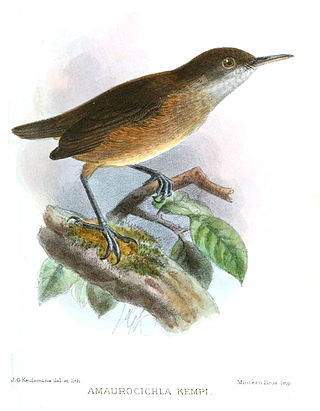The Old World warblers are a large group of birds formerly grouped together in the bird family Sylviidae. They are not closely related to the New World warblers. The family held over 400 species in over 70 genera, and were the source of much taxonomic confusion. Two families were split out initially, the cisticolas into Cisticolidae and the kinglets into Regulidae. In the past 20–30 years they have been the subject of much research and many species are now placed into other families, including the Acrocephalidae, Cettiidae, Phylloscopidae, and Megaluridae. In addition some species have been moved into existing families or have not yet had their placement fully resolved. Only a small number of warblers, in just two genera, are now retained in the family Sylviidae.

Alaemon is a genus of birds in the family Alaudidae, commonly called hoopoe larks.

The painted berrypeckers, Paramythiidae, are a very small bird family restricted to the mountain forests of New Guinea. The family comprises three species in two genera: the tit berrypecker in Oreocharis, and the eastern crested berrypecker and western crested berrypecker in Paramythia. These are colourful medium-sized birds which feed on fruit and some insects. These species were formerly included in the Dicaeidae, but DNA–DNA hybridization studies showed these species were related to each other but distinct from the flowerpeckers. Some sources group painted berrypeckers as two genera belonging to the berrypecker family Melanocharitidae.

The Melanocharitidae, the berrypeckers and longbills, is a small bird family restricted to the forests of New Guinea. The family contains eleven species in four genera. They are small songbirds with generally dull plumage but a range of body shapes.

Passerida is, under the Sibley-Ahlquist taxonomy, one of two parvorders contained within the suborder Passeri. While more recent research suggests that its sister parvorder, Corvida, is not a monophyletic grouping, the Passerida as a distinct clade are widely accepted.

Macrosphenus is a genus of African warblers, formerly placed in the family Sylviidae. It is one of two genera in that family known as longbills.

The Benguela long-billed lark, also known as the Benguela lark or Benguela longbill is a species of lark in the family Alaudidae. It is found in south-western Africa. Its natural habitat is subtropical or tropical dry lowland grassland.

The Karoo long-billed lark or Karoo longbill is a species of lark in the family Alaudidae. It is found in southern Africa in its natural habitat of subtropical or tropical dry shrubland.

The thick-billed berrypecker is a species of bird in the berrypecker and longbill family Melanocharitidae. It is found in New Guinea. Its natural habitat is subtropical or tropical moist montane forest. The spotted berrypecker was formerly considered conspecific, but it was split as a distinct species by the IOC in 2021.
Melanocharis is a genus of birds in the family Melanocharitidae that are endemic to New Guinea.

The pygmy longbill or pygmy honeyeater is a species of bird in the family Melanocharitidae. It is one of two species in the genus Oedistoma, which also includes the spectacled longbill. It is found in New Guinea and adjacent islands. Its natural habitats are subtropical or tropical dry forest and subtropical or tropical moist lowland forest.

Oedistoma is a genus of longbill in the bird family Melanocharitidae. The genus, like the family, is endemic to New Guinea. The genus contains two species, both of which are sometimes placed in the genus Toxorhamphus.

The spectacled longbill, also known as dwarf longbill, plumed longbill or dwarf honeyeater, is a species of bird in the family Melanocharitidae. It is found in New Guinea. Its natural habitats are subtropical or tropical dry forest, subtropical or tropical moist lowland forest, and subtropical or tropical moist montane forest.

The yellow-bellied longbill or green-crowned longbill is a species of bird in the family Melanocharitidae. It is found in New Guinea. Its natural habitats are subtropical or tropical moist lowland forest and subtropical or tropical moist montane forest.

The slaty-headed longbill or grey-winged longbill is a species of bird in the family Melanocharitidae. It is found in the New Guinea Highlands. Its natural habitats are subtropical or tropical moist lowland forest and subtropical or tropical moist montane forest.

The satinbirds or cnemophilines, are a family, Cnemophilidae of passerine birds which consists of four species found in the mountain forests of New Guinea. They were originally thought to be part of the birds-of-paradise family Paradisaeidae until genetic research suggested that the birds are not closely related to birds-of-paradise at all and are perhaps closer to berry peckers and longbills (Melanocharitidae). The current evidence suggests that their closest relatives may be the cuckoo-shrikes (Campephagidae).

The African warblers are a newly erected family Macrosphenidae, of African songbirds. Most of the species were formerly placed in the Old World warbler family Sylviidae, although one species, the rockrunner, was placed in the babbler family, Timaliidae. A series of molecular studies of the Old World warblers and other bird families in the superfamily Sylvioidea found that the African warblers were not part of Sylviidae but were instead an early (basal) offshoot of the entire clade Sylvioidea. Some taxonomic authorities place the entire family Hyliidae here.

Rhamphocharis is a genus of berrypecker in the family Melanocharitidae that are endemic to New Guinea.

















